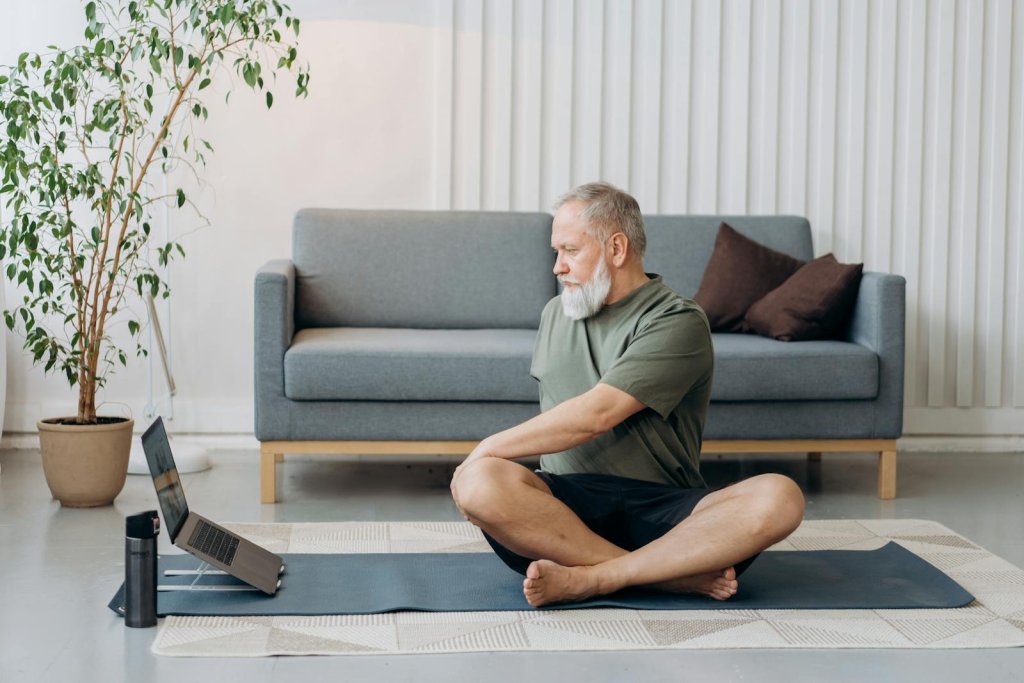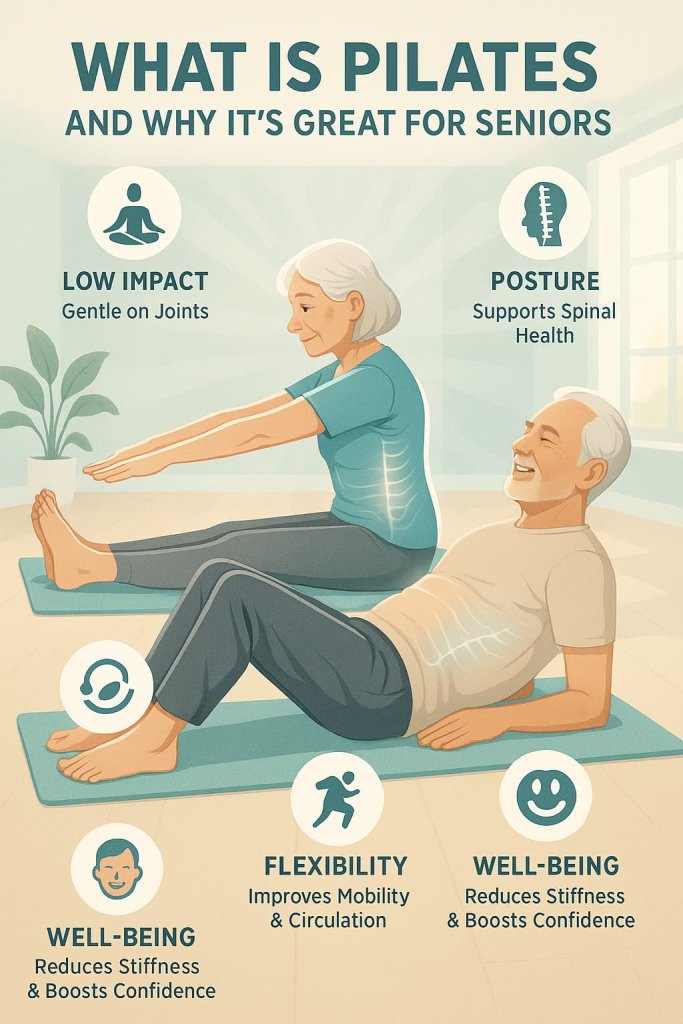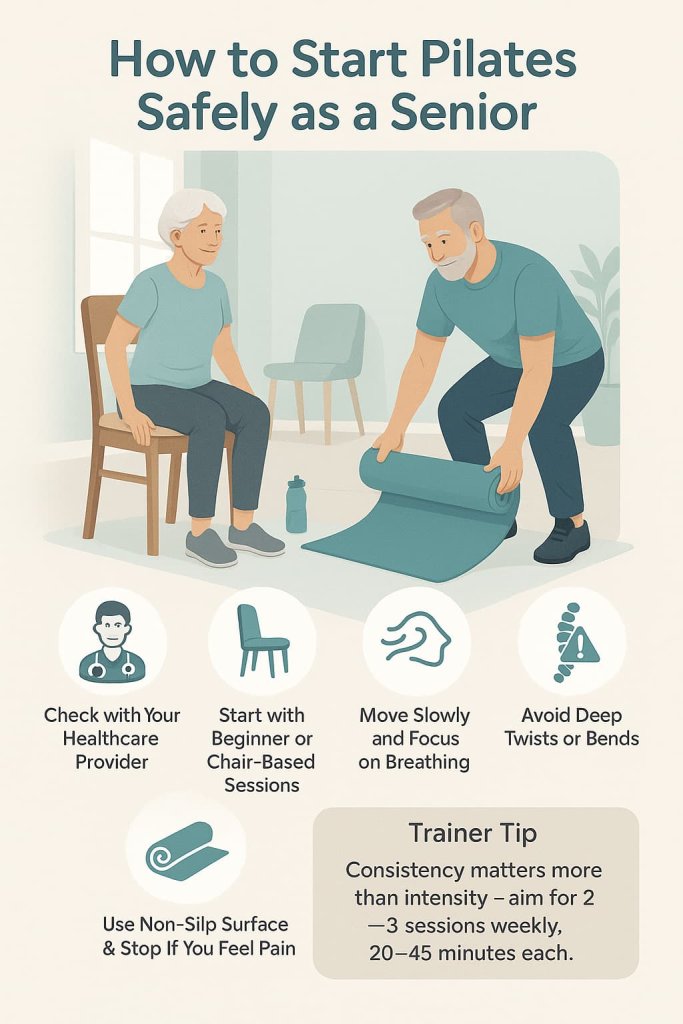Pilates is one of the safest and most effective ways for seniors to improve strength, balance, and flexibility. It’s a gentle, low-impact form of exercise that focuses on core control, posture, and mindful movement—making it ideal for aging adults who want to stay strong and mobile without stressing their joints.

Understanding Pilates is important because it strengthens stabilizing muscles, enhances coordination, and supports spinal alignment—all of which help maintain independence and prevent falls as you age. Whether you’re new to exercise or returning after a long break, these 12 Pilates moves can help you regain confidence and function safely.
What Is Pilates and Why It’s Great for Seniors
Pilates, developed by Joseph Pilates in the early 20th century, emphasizes controlled movements, proper breathing, and core engagement. Unlike high-impact workouts, Pilates uses slow, precise exercises that build muscle strength and flexibility simultaneously.

Why it works for older adults:
- Low-impact and joint-friendly
- Enhances posture and spinal health
- Strengthens the core (which supports balance)
- Boosts flexibility and circulation
- Reduces stiffness and pain associated with aging
According to Harvard Health , Pilates helps improve posture, balance, and muscle tone while reducing fall risk in older adults. A 2023 BMC Geriatrics review found that consistent Pilates training significantly enhanced mobility and physical function in participants over 60.
How to Start Pilates Safely as a Senior
Before starting, check with your healthcare provider—especially if you have osteoporosis, arthritis, or chronic pain.

Safety tips:
- Begin with beginner or chair-based sessions.
- Move slowly and focus on breathing.
- Avoid any sharp twisting or deep forward bends if you have spinal issues.
- Practice on a non-slip mat or carpeted floor.
- Stop if you feel pain, dizziness, or shortness of breath.
Trainer Tip: Consistency matters more than intensity. Aim for 2–3 sessions per week, about 20–45 minutes each.
12 Best Pilates Exercises for Seniors
Below are 12 safe, effective Pilates moves to help seniors strengthen muscles, improve posture, and maintain mobility.
1. Pelvic Tilt
Why it works:
Strengthens the abdominal and lower back muscles, improving posture and spinal stability. It helps relieve back tension and prepares your core for other movements.
Muscles worked:
Core, lower back, glutes.
How to do it:
- Lie on your back with knees bent and feet flat on the floor.
- Inhale deeply to prepare.
- Exhale while gently tightening your abdominal muscles, flattening your lower back into the mat.
- Hold for 3 seconds, then slowly release.
- Repeat for 10–12 repetitions.
Trainer Tip:
Keep movements slow and controlled—avoid arching your back during the release phase.
2. Knee Folds
Why it works:
Improves balance and core control while strengthening deep abdominal stabilizers.
Muscles worked:
Lower abs, hip flexors, core stabilizers.
How to do it:
- Lie on your back with knees bent and arms relaxed at your sides.
- Inhale to prepare.
- Exhale and lift one knee toward your chest until your thigh is vertical.
- Inhale as you lower it back down and switch legs.
- Alternate for 10–12 repetitions per side.
Trainer Tip:
Keep your pelvis stable and avoid rocking your hips as you lift each leg.
3. Seated Spine Stretch
Why it works:
Enhances spinal mobility and posture while lengthening tight hamstrings.
Muscles worked:
Hamstrings, spinal extensors, shoulders.
How to do it:
- Sit tall with legs extended in front of you, feet flexed.
- Inhale to sit taller.
- Exhale as you reach forward from the waist, keeping your spine long (not rounded).
- Hold for 2 seconds, then slowly roll back up.
- Repeat 8–10 times.
Trainer Tip:
Visualize stacking your spine one vertebra at a time as you return upright—avoid slumping forward.
4. Leg Circles
Why it works:
Improves hip joint mobility and strengthens the core for better control and coordination.
Muscles worked:
Core, hips, inner and outer thighs.
How to do it:
- Lie flat on your back, one leg extended on the mat, the other raised straight toward the ceiling.
- Engage your abs to keep hips steady.
- Inhale as you circle the lifted leg clockwise; exhale to circle counterclockwise.
- Perform 8–10 small circles in each direction, then switch legs.
Trainer Tip:
Keep circles small and controlled to protect your lower back—focus on precision, not speed.
5. The Hundred (Modified)
Why it works:
Boosts blood flow and warms up the body while strengthening the core.
Muscles worked:
Abdominals, chest, shoulders.
How to do it:
- Lie on your back with knees bent and feet lifted off the mat (tabletop position).
- Raise head and shoulders slightly, extend arms by your sides.
- Pump arms up and down in small motions while inhaling for 5 counts and exhaling for 5 counts.
- Continue for 5–10 breath cycles.
Trainer Tip:
If you feel neck strain, rest your head on the mat and continue pumping your arms.
6. Seated Leg Lifts
Why it works:
Strengthens the legs and enhances sitting balance, making daily tasks like standing easier.
Muscles worked:
Quadriceps, hip flexors, core.
How to do it:
- Sit tall in a sturdy chair with feet flat on the floor.
- Inhale, then exhale as you lift one leg straight out in front of you.
- Hold for 2 seconds, then lower slowly.
- Alternate legs for 10–12 reps each.
Trainer Tip:
Avoid leaning backward—engage your core to stay upright throughout.
7. Standing Roll Down
Why it works:
Increases spinal mobility, stretches the back, and promotes better posture.
Muscles worked:
Hamstrings, spinal extensors, shoulders.
How to do it:
- Stand tall with feet hip-width apart.
- Inhale deeply, then exhale as you slowly roll your head and spine forward toward your toes.
- Let arms hang relaxed.
- Inhale to start rolling back up, one vertebra at a time.
- Repeat 6–8 times.
Trainer Tip:
Move gently and avoid locking your knees. Focus on controlled breathing during the roll.
8. Side Leg Lifts
Why it works:
Improves hip strength and lateral balance, supporting everyday movement and fall prevention.
Muscles worked:
Gluteus medius, outer thighs, obliques.
How to do it:
- Lie on your side with legs extended and head supported on your arm.
- Exhale as you lift your top leg upward to hip height.
- Inhale to lower it back down slowly.
- Perform 10 reps per side.
Trainer Tip:
Keep hips stacked vertically—avoid rolling backward or forward.
9. Shoulder Bridge
Why it works:
Strengthens glutes, hamstrings, and lower back while enhancing spinal alignment.
Muscles worked:
Glutes, hamstrings, lower back, and core.
How to do it:
- Lie on your back with knees bent and feet hip-width apart.
- Inhale, then exhale as you lift your hips until shoulders, hips, and knees form a straight line.
- Hold for 3–5 seconds, then lower slowly.
- Repeat 8–10 times.
Trainer Tip:
Press evenly through your feet—avoid pushing your hips too high or arching your lower back.
10. Cat-Cow Stretch
Why it works:
Improves flexibility in the spine and relieves tension in the back and shoulders.
Muscles worked:
Spinal extensors, shoulders, abdominals.
How to do it:
- Begin on hands and knees, wrists under shoulders, knees under hips.
- Inhale as you drop your belly, lift your head, and arch your back (cow).
- Exhale as you round your spine, tucking your chin (cat).
- Continue for 8–10 slow cycles.
Trainer Tip:
Move with your breath—avoid forcing the stretch or dropping your lower back.
11. Mermaid Stretch
Why it works:
Enhances flexibility in the spine and sides of the body, promoting better breathing and posture.
Muscles worked:
Obliques, intercostals, shoulders.
How to do it:
- Sit on the floor with legs folded to one side.
- Place one hand on the floor beside you.
- Inhale and reach your opposite arm overhead, leaning gently toward the floor.
- Hold for 2–3 breaths, then switch sides.
- Repeat 6–8 times per side.
Trainer Tip:
Focus on lengthening rather than bending—keep both hips grounded for a deeper stretch.
12. Wall Roll-Down
Why it works:
Improves posture awareness, spinal articulation, and core strength.
Muscles worked:
Core, back, shoulders.
How to do it:
- Stand with your back against a wall, feet about 6 inches away.
- Inhale, then exhale as you slowly roll your spine off the wall, one vertebra at a time.
- Inhale to pause at the bottom, exhale as you roll back up.
- Repeat 6–8 times.
Trainer Tip:
Keep your core engaged—imagine peeling your spine from the wall slowly for maximum control.
How Often Should Seniors Do Pilates?
Most experts recommend doing Pilates 2–4 times per week for optimal results. Even two 20-minute sessions can improve posture, strength, and flexibility.
For beginners:
- Start with 20–30 minutes of mat or chair Pilates.
- Gradually increase duration as comfort improves.
- Combine with light walking or balance training for a complete routine.
Benefits of Pilates for Seniors
- Improves balance and coordination, reducing fall risk.
- Strengthens the core, supporting spine and joints.
- Enhances flexibility and joint range of motion.
- Promotes better posture and alignment.
- Supports bone health and reduces stiffness.
- Boosts mood and mental focus through mindful breathing.
Common Mistakes to Avoid
- Moving too quickly instead of focusing on control.
- Holding your breath—always breathe through each move.
- Overarching the lower back.
- Skipping warm-up or cool-down.
- Ignoring pain signals.
Pro Tips for Making Pilates Easier and More Effective
- Use a chair or block for support
- Start with 15–20 minute sessions
- Move slowly with control
- Focus on steady breathing
- Modify if you feel discomfort
- Stay consistent for lasting results
Trainer Tip: Slow, precise movements bring better results than fast, forced ones.
FAQs
1. Is Pilates safe for seniors with arthritis or osteoporosis?
Yes—Pilates can be safe with modifications. Avoid forward flexion (bending) and twisting if you have spinal issues. Consult your doctor first.
2. How often should seniors do Pilates?
2–3 sessions per week is ideal for beginners to build consistency and see improvements.
3. What equipment do I need?
A non-slip mat, light resistance band, and supportive chair are enough for most routines.
4. Can Pilates improve balance?
Yes, studies show Pilates enhances core stability and proprioception, which are key for balance.
5. Is chair Pilates effective?
Absolutely. Chair Pilates offers all major benefits—strength, posture, and flexibility—without floor work.
6. How soon will I see results?
With regular practice, most seniors notice improvements in 4–6 weeks in posture, flexibility, and mobility.
7. Can I combine Pilates with walking or yoga?
Yes—Pilates pairs perfectly with light cardio or stretching for full-body wellness.
Conclusion
Pilates is one of the most senior-friendly workouts available—gentle on joints yet powerful in improving strength, balance, and flexibility. With consistent practice, you’ll move with more confidence, reduce pain, and feel energized daily.
Start today with a 20-minute beginner routine, and let your body rediscover control, strength, and stability.
References
- Archives of Gerontology and Geriatrics (2024) – Meta-analysis on Pilates and balance (PubMed)
https://pubmed.ncbi.nlm.nih.gov/39068875/ - Harvard Health (2024) – Exercise programs that improve balance (includes mat Pilates)
https://www.health.harvard.edu/healthbeat/exercise-programs-that-improve-balance - Frontiers in Medicine (2021) – Falls-risk factors and exercise; mat Pilates dosage linked to postural stability
https://www.frontiersin.org/journals/medicine/articles/10.3389/fmed.2021.708883/full - Royal Osteoporosis Society – Pilates with osteoporosis (safety modifications)
https://theros.org.uk/information-and-support/osteoporosis/living-with-osteoporosis/exercise-and-physical-activity-for-osteoporosis/caring-for-your-back/pilates-with-osteoporosis/ - Musculoskeletal Science and Practice (2022) – 6-week Pilates improves postural control (trial)
https://www.sciencedirect.com/science/article/abs/pii/S1360859221001339
